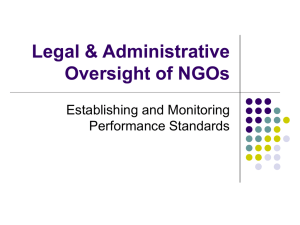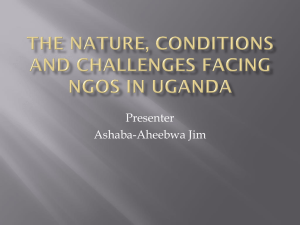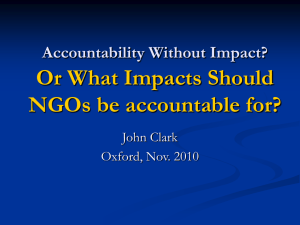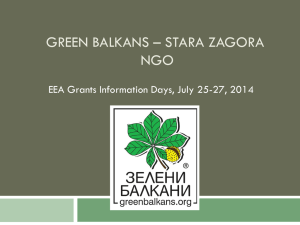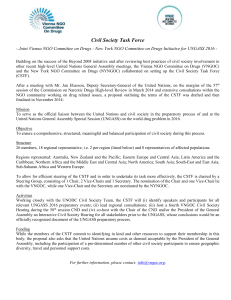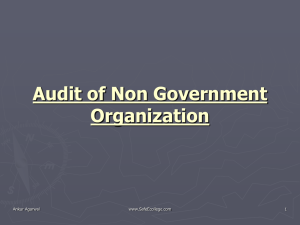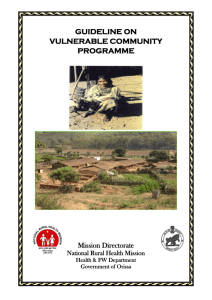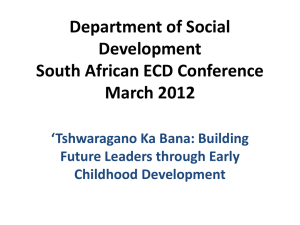Presentation
advertisement
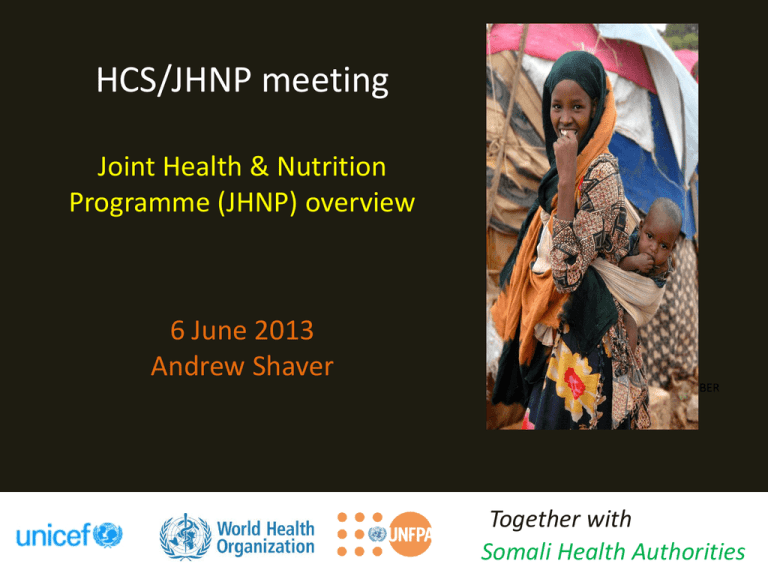
HCS/JHNP meeting Joint Health & Nutrition Programme (JHNP) overview 6 June 2013 Andrew Shaver Image: UNICEF/SOMA2006/ KAMBER Together with Somali Health Authorities Presentation Synopsis Programme Overview Programme Plan 2013 Standardizing Operating Procedures (Including NGO selection) Budget/ Funding Information Overview • A Somali development programme which aims to: – To scale up the delivery of essential services for women, girls and children in Somaliland, Puntland and Central South Somalia – Strengthen the Somali Public Health System by establishing well informed governance and management arrangements – Developing the leadership capacity of the Somali Health Authorities 3 Overview Goals 2016: Reduced maternal mortality (by 10%) Reduced child mortality (by 15%) Reduced underweight children (by 10%) and Reduced FGM/C (by 10%) Increase in peace and security And improve the systems that support better health for Somalis. 4 Overview: Programme Focus • Target group: 3.4 million Somalis (circa 1/3 population) • Initial focus areas: Puntland: Nugal, Mudug, Bari SCZ: Benadir, Gedo, Galgaduk Somaliland: X, Togadeer, Awal • Health authorities have requested changes in SL (Sahil > Sanaag > maybe Maroodi Jeex) • National (all areas), district and community based interventions- based on HSSPs 5 Roll over Programme Plan 2012- 2013 Priorities from HSSPs will be funded by tranches 5, 6 and 7 in the JHNP Annual Workplan. The Annual Workplan to be finalized once the aligned logframe is approved. (Final processes ongoing) Current workplan priorities 2013 (tranche 5), based on HSSPs include: • • • • • • • • Developing a procurement and service contracting strategy and unit for the MoH in three zones Focus on family planning policies for 3 zones, guidelines for health worker staff, commodity procurement (inc contraceptives) and training of family planning counselors and health care workers in modern contraceptive methods. Human resource assessments, plans and policies (SL/SCZ) to strengthen financial accountability systems Salary support to key MoH staff within three zones (based on HR plans) EPHS core activities in JHNP areas and procurement of EPHS supplies and commodities (largest proportion of funds) Establishing and implementing an essential drug list and national formulary, supply chain management masterplan Support to the HSAT Assessment of current health care financing to lead to strategy development Programme projected budget The programme has a 5 year $236Million aspirational budget Output 1: Improved governance and leadership at all levels of the health sector Output 2: Skilled and motivated health workforce distributed equally and equipped to deliver quality RMNCH and nutrition services through a continuum of care Output 3: Increased access, quality and demand for essential RMNCH and nutrition services Output 4: Improved access, availability, quality and rational use of essential medicines, vaccines and medical equipment and physical structures Output 5: Improved availability, quality and use of health information that covers disease surveillance as well as management information system Output 6: Steady progress made to an equitable and efficient health financing system Technical Assistance and Programme Management Support Costs Total programmable amount Agencies HQ recovery cost GRAND TOTAL $7,425,000 $13,287,000 $145,471,500 $18,575,000 $3,721,500 $1,990,000 $29,784,800 $220,254,800 $16,578,390.00 $236,833,190.00 7 SOPs SOP001: Activity prioritization/budget allocation Standardizing JHNP processes to improve accountability, transparency, efficiency and good governance Principles: - Decentralization of decision making - Alignment to HSSPs & each zone’s specific needs - Equity - Transparency and integrity SOP002 (Implementing Partner Selection) Rationale • Document the process for selecting NGO implementing partners for JHNP • Clarifies collaborative arrangements between Somali Health Authorities and UN at zonal and Nairobi Levels Scope • Focused on NGO partners for service delivery within zones (e.g, PCAs with UNICEF) • Standardized/transparent selection of partners • Does not seek to change existing UN rules /procedures or contracting modalities, which must be UN led. 10 SOP002: Implementing Partner Selection Non-competitive selection: “when an existing partner, who meets the selection criteria, is covering all, or a significant proportion, of an administrative area. See the generic selection criteria for JHNP partners, which is to be accompanied and completed alongside the relevant UN agency’s standard criteria.” SOP002- Selection Criteria Yes/No 1 2 3 Does the NGO have an MOU or official agreement with the Health Authorities? (in the case of South Central Somalia: has NGO expressed a willingness to sign an MOU?) Does the NGO have a track record of working with the Health Authorities at regional level and/or central level? Is the NGO currently working in the geographical region/district covered by the proposed contract? Note: if yes, for how long? 4 Does the NGO have development experience in health service delivery at PHC Level? 5 Does the NGO manage a (health facility) within the district/region? 6 Can the NGO provide proven evidence of having delivered similar services (to be defined by ZWG) of acceptable quality (to be defined by ZWG) within the region/district? 7 Does the NGO have a proven track record of quality service provision (evidenced by reports and preferably documented site visits)? If not, a joint capacity assessment must be undertaken by the selecting body (request of risk assessment (UNDP) can be sought for) Is the size of the NGO’s existing programme relative to the size of the proposal? 8 9 10 11 12 Can the NGO contribute its own funds in the case of cash stock-out? Does the NGO have documented evidence of using local capacities? Does the NGO regularly attend zonal Health NGOs, Health Sector and Health Cluster meetings? Does the NGO have experience working with an UN agency? Or ZWG may choose 1-5 points scale SOP002: Implementing Partner Selection RFA: when (a) there are three or more NGOs operating in a region who meet the JHNP selection criteria or (b) in instances when the JHNP is moving into a new implementation region and the capacity of partners operating in that region is not known. SOP002 (Con’t) • UN managing the awards (ie, UNICEF PCAs), MoH primary interface • ‘Transition’ SOP whilst capacity of MoH develops to manage contracts directly (post JHNP) Budget/Funding Info Donors DFID= USD 20.968 million 3,131,520.00 1,150,000 4,805,000.00 SIDA = USD 4.805 million Ausaid = USD 3.132 million USAID = USD 1.150 million 1 20,968,000.00 2 3 4 Programme projected budget • The programme has a 5 year $236Million aspirational budget Output 1: Improved governance and leadership at all levels of the health sector Output 2: Skilled and motivated health workforce distributed equally and equipped to deliver quality RMNCH and nutrition services through a continuum of care Output 3: Increased access, quality and demand for essential RMNCH and nutrition services Output 4: Improved access, availability, quality and rational use of essential medicines, vaccines and medical equipment and physical structures Output 5: Improved availability, quality and use of health information that covers disease surveillance as well as management information system Output 6: Steady progress made to an equitable and efficient health financing system Technical Assistance and Programme Management Support Costs Total programmable amount Agencies HQ recovery cost GRAND TOTAL $7,425,000 $13,287,000 $145,471,500 $18,575,000 $3,721,500 $1,990,000 $29,784,800 $220,254,800 $16,578,390.00 $236,833,190.00 17 Current funds: Tranche Five Building Block/ Programme Pillar 1. Leadership and governance Tranche 5 $1,937,000 2. Skilled and motivated health workforce $2,157,200 3. RMNCH Service Delivery $6,660,000 4. Essential medicines, vaccines and medical equipment $1,759,000 and physical structures 5. Improved health information $580,000 6. Health financing $150,000 Total Programmable Amount $12,793,200 Programme funding- beyond 2013 2012 2013 2014 Dfid $2,352,850 $30,458,522 $12,991,804 SIDA $4,804,680 $4,812,000 AUSAID $3,131,520 USAID $1,149,963 TOTAL pledged 2011 budget % $11,439,013 $35,270,522 $12,991,804 23,819,535.56 53,957,304.83 71,943,093.21 48% 65% 18% 2015 71,943,093.21 0% Mahadsanid, Thank you, & Questions
